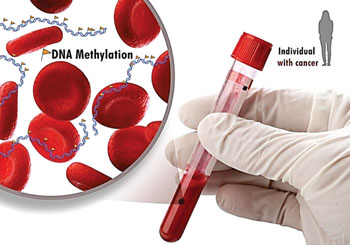Blood Test Developed to Detect Five Early-Stage Cancers
By LabMedica International staff writers
Posted on 28 Feb 2016
A blood test to diagnose common types of cancer is in development after it was found that five forms of the disease share a telltale chemical signature.Posted on 28 Feb 2016
DNA from tumors can circulate in the bloodstream, and it has been proposed that it would be possible to detect this change and diagnose cancer from a standard blood test. DNA methylation acts like a chemical “dimmer switch” on genes: an increase in methylation causes a decrease in gene activity.

Image: A blood test for DNA methylation levels of the gene encoding zinc finger protein 154 (ZNF154) can diagnose common cancers (Photo courtesy of US National Institutes of Health).
Scientists at the US National Human Genome Research Institute (Rockville, MD, USA) and their colleagues focused on the possibility of using the enhanced methylation as a reliable indicator of cancer. The team compared 184 samples from five different tumor types with 34 normal, non-cancerous tissue samples. Importantly, they found that this genetic change was consistent across the five different types of cancer, suggesting that it could be used as a universal cancer marker. The study also showed that the enhanced methylation was detectable even at very low concentrations in the blood, meaning that a blood test could be used to identify cancer from early-stage tumors.
The team found that tumors in colon, lung, breast, stomach and endometrium share a change in a gene called zinc finger protein 154 (ZNF154). They measured the magnitude and pattern of differential methylation of this region across colon, lung, breast, stomach, and endometrial tumor samples using next-generation bisulfite amplicon sequencing. They found that all tumor types and subtypes are hypermethylated at this locus compared with normal tissue. To evaluate this site as a possible pan-cancer marker, they compared the ability of several sequence analysis methods to distinguish the five tumor types from normal tissue samples. Furthermore, in a computational simulation of circulating tumor DNA, they were able to detect limited amounts of tumor DNA diluted with normal DNA: 1% tumor DNA in 99% normal DNA.
Laura Elnitski, PhD, a senior investigator and coauthor of the study, said, “'We have laid the groundwork for developing a diagnostic test, which offers the hope of catching cancer earlier and dramatically improving the survival rate of people with many types of cancer. Finding a distinctive methylation-based signature is like looking for a spruce tree in a pine forest. It's a technical challenge to identify, but we found an elevated methylation signature around the gene known as ZNF154 that is unique to tumors.” The study was published on February 5, 2016, in the Journal of Molecular Diagnostics.
Related Links:
US National Human Genome Research Institute














